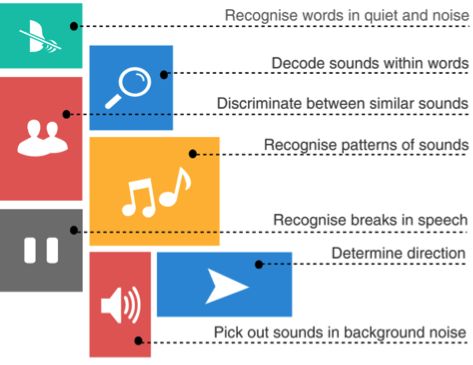Auditory Processing
Understanding what we hear
Auditory processing can be broadly described as ‘what we do with what we hear’. At More Than Hearing we are committed to providing the most up-to-date and comprehensive auditory processing assessments, auditory training therapy and effective classroom strategies available.
3 steps
Hearing and comprehension involves three primary processes: hearing, listening and processing. The first stage is hearing. This is necessary for both effective listening and auditory processing. Listening is the active process by which one pays attention to what is being said. If there is a breakdown in either hearing or listening, processing will be affected. After the sound hits the ear drum, the signal is sent to the brain where it is analysed and processed. This marks the beginning of the auditory processing stage where our brain decodes sounds into words and assigns meaning.
What we do when we hear a sound

Attention and memory skills
- Effective listening encompasses a range of attention and memory skills: selective attention, divided attention, short-term auditory memory and functional memory.
- Selective attention involves focused attention on a particular task while ignoring others.
- Divided attention involves focusing on two types of information presented at the same time.
- Short-term auditory memory is the ability to retain and recall information without needing to process it.
- Functional/working memory is the ability to temporarily retain information in order to work through it.
Hearing in noisy environments
Understanding speech in noisy environments is a problem commonly experienced by children with auditory processing disorders. However, assessing one’s ability to hear in noise is more complex than simply testing one’s hearing.
There is a range of factors which may affect one’s ability to hear in noise, including the brain’s ability to process competing noise from both ears at the same time. Therefore, auditory processing plays a major role in hearing in noisy environments.
LiSN-S
The Listening in Spatialized Noise – Sentences Test (LISN-S) was developed in Australia by the National Acoustic Laboratories.The test assesses auditory skills in children who may be having difficulty listening to and following speech in the classroom.
The LISN-S is a pure auditory test and does not measure language learning or communications skills. Instead, the test assesses the ability to understand speech when noise is arriving from different directions. It is a more realistic and functional way of recreating real-life situations and, through this process, it is able to effectively assess performance in different conditions.
The LiSN-S assesses the child’s hearing comprehension in four different conditions. It provides information as to what the child relies on to hear in competing noise: spatial cues, voice cues or both.
